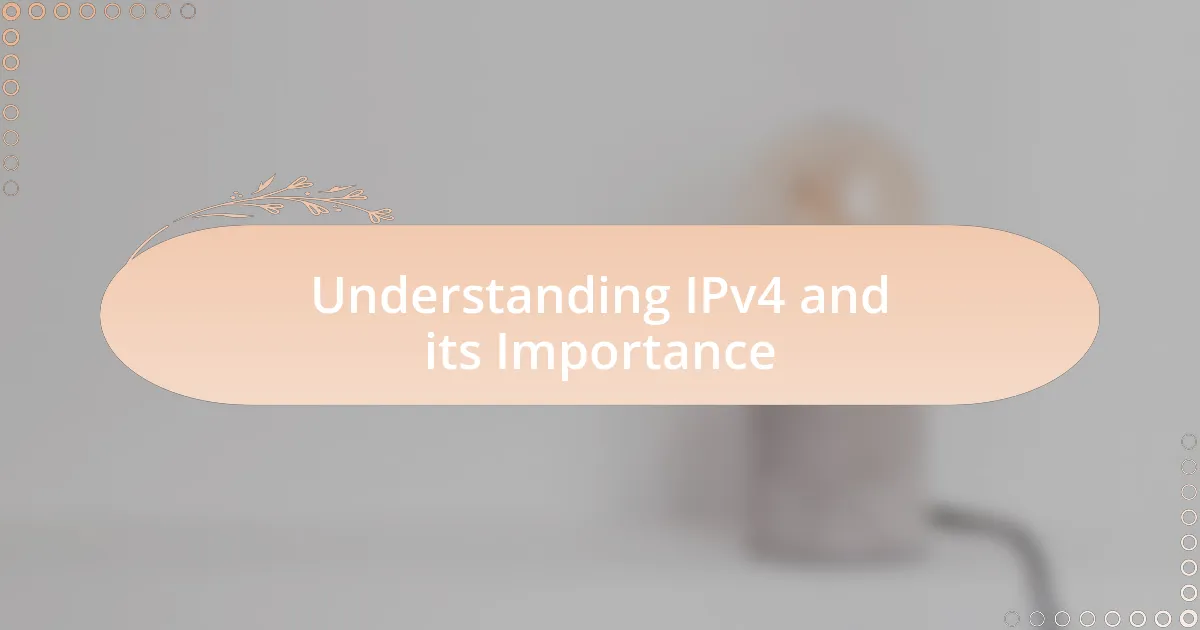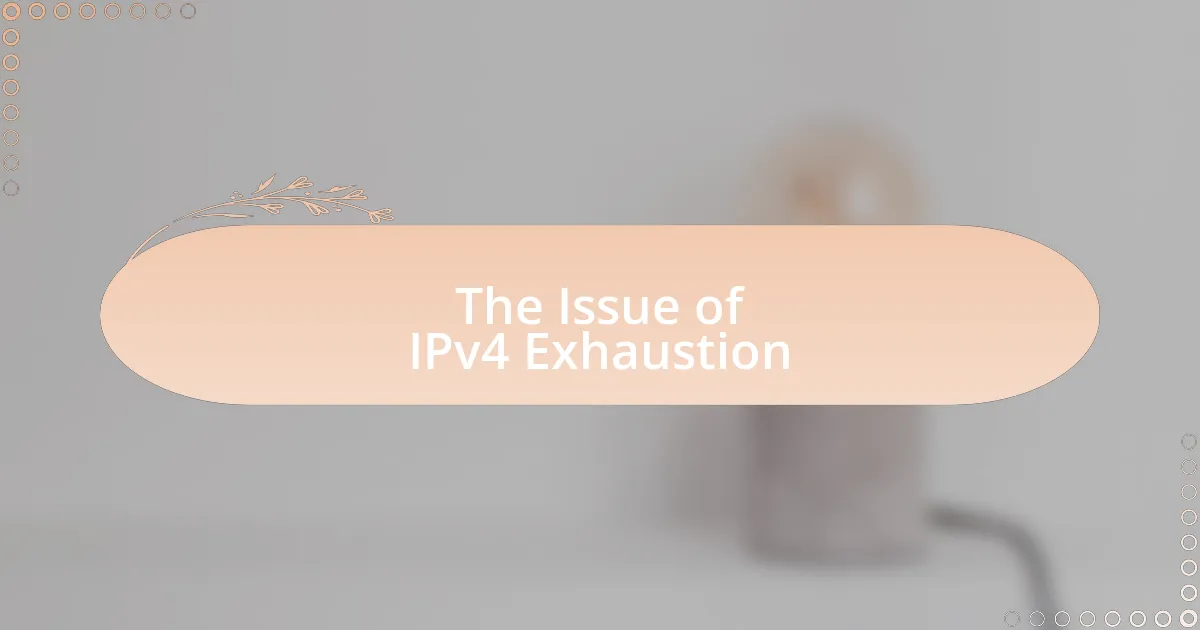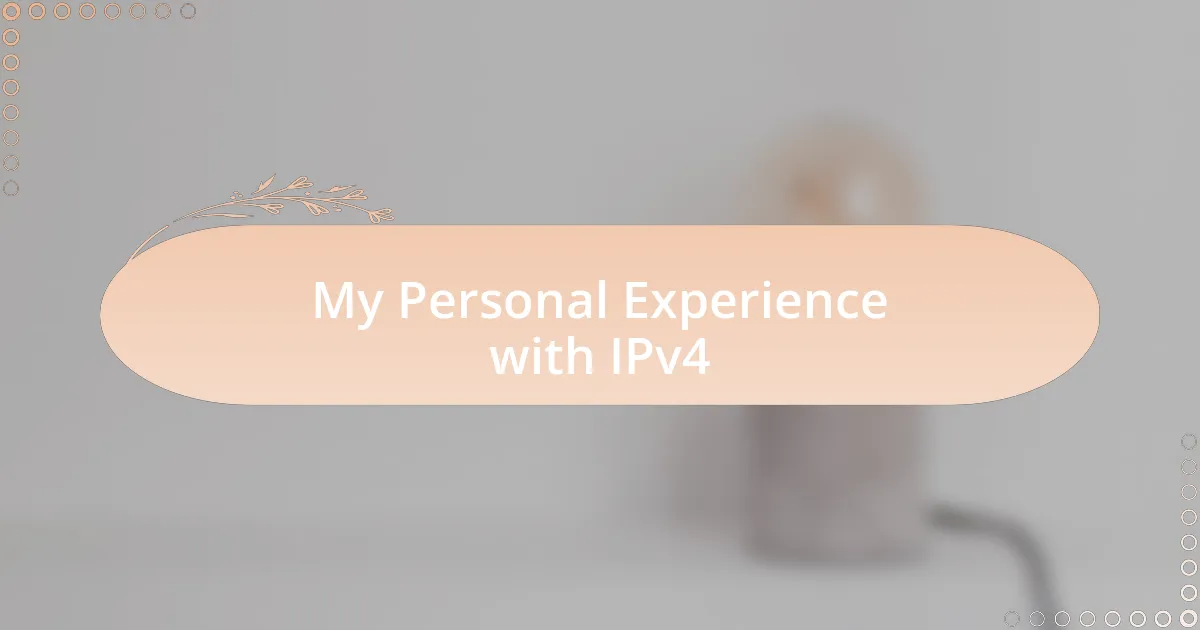Key takeaways:
- IPv4 addresses are running out, creating challenges for businesses due to limited connectivity and rising costs.
- The transition to IPv6 is essential, offering vast address space and improved efficiency for future digital growth.
- Proactive planning, team training, and phased implementation are crucial for a smooth transition to IPv6.
- Emerging technologies like 5G, enhanced cybersecurity, and AI integration are reshaping telecommunications and addressing connectivity challenges.

Understanding IPv4 and its Importance
IPv4, or Internet Protocol version 4, is the backbone of our digital communication. It was one of the first protocols established for routing data across networks, allowing devices to connect seamlessly. I remember my early days in tech, tinkering with network settings just to see how changing an IP address could impact connectivity—it was like a puzzle, revealing the intricacies of how data travels.
The significance of IPv4 cannot be overstated; it provides unique IP addresses that enable devices to communicate over the internet. When I reflect on the early growth of the internet, it’s astounding how we once thought there were more than enough addresses to go around. Did anyone really foresee a day when we’d exhaust these seemingly endless combinations?
As we explore this topic, I feel it’s crucial to recognize that IPv4 addressed a fundamental need for device identification. But the limitation it presents today becomes a pressing challenge. Have you ever experienced a delayed connection because your device couldn’t acquire an address? It’s moments like these that illustrate the urgency of the IPv4 exhaustion dilemma, pushing us to look toward future solutions like IPv6.

The Issue of IPv4 Exhaustion
As we delve into the issue of IPv4 exhaustion, it’s hard not to feel a sense of urgency. I recall when I first learned about IP addressing; managing network configurations felt manageable. Yet, witnessing the rapid growth of connected devices, especially with the rise of smartphones and IoT, I often found myself questioning how we would adapt when those available IPv4 addresses ran out.
The reality of IPv4 exhaustion is stark: with approximately 4.3 billion unique addresses and billions of devices connected to the internet, the numbers simply don’t add up. It’s akin to standing in a room full of people where every seat is taken, and new guests keep arriving. Have you ever experienced a situation where you just couldn’t get a connection because all the “seats” were taken? That’s the scenario we find ourselves in, and it leaves me feeling a bit anxious about our infrastructure’s future.
Moreover, as businesses expand and digital transformation accelerates, the consequences of this exhaustion are becoming increasingly tangible. I remember advising a small startup on networking; they were thrilled about connecting their new devices but quickly hit the wall of available IP addresses. It struck me then that IPv4 exhaustion isn’t just a technical issue—it’s a roadblock that could hinder innovation and growth in our increasingly digital world. How do we solve this? The transition to IPv6 is more than necessary; it’s essential for our digital future.

Impacts of IPv4 Exhaustion
As IPv4 addresses dwindle, many companies face significant operational hurdles. I’ve seen businesses struggle to acquire the necessary addresses to scale their services. It’s almost like watching a ship trying to set sail with too few lifeboats; without adequate resources, there’s a real risk of capsizing under their own ambitions.
One of the most immediate impacts I’ve noticed is the rise in costs associated with IP address acquisition. When I was working on a project involving network growth, we found ourselves financing the purchase of previously unused IP blocks from companies that had surplus addresses. It felt unsettling. Why should access to something as essential as IP addresses come with a hefty price tag? This surge in demand drives up costs, making it harder for startups and smaller firms to establish their online presence.
Additionally, the technical complexities surrounding IPv4 exhaustion can result in fragmented networks, creating inefficiencies and security vulnerabilities. I recall a case where a client’s network suffered due to poorly managed IP allocations, leading to frequent outages. This not only frustrated users but also drained resources that could’ve fueled innovation. In a world increasingly driven by technology, why should possible roadblocks like these continue to exist?

Exploring IPv6 as a Solution
Exploring IPv6 represents a pivotal shift in how we can address the limitations imposed by IPv4. I remember when my team transitioned to IPv6; it felt like unlocking a treasure chest of possibilities. The vast address space—over 340 undecillion addresses—means that every device can have its own unique address, sparking innovation rather than stifling it. Isn’t it liberating to consider that we could connect every device without worrying about exhausting our resources?
What struck me most during the transition was the enhanced efficiency and security that IPv6 offers. I worked on a project where the implementation of IPv6 resulted in reduced network complexity. For instance, the built-in features like stateless address autoconfiguration simplified managing devices significantly. As we streamlined operations, it felt like we’d traded in a cluttered toolbox for one that was organized and efficient. How often do we crave simplicity in technology that feels perpetually overwhelming?
Moreover, the interaction of IPv6 with modern technologies like IoT has been transformative. In a workshop I attended, experts discussed how IPv6 is crucial for the future of connected devices. It lit a spark within me—imagine smart cities powered by billions of interconnected devices, all thriving on the expansive framework of IPv6. The question isn’t whether we should embrace this evolution but rather how quickly we can adapt to harness its full potential.

My Personal Experience with IPv4
Reflecting on my early days in networking, I remember being captivated by the limitations posed by IPv4. It was perplexing to see how often we had to allocate IP addresses judiciously, almost like playing a game of chess with limited pieces. I vividly recall a project where we ran out of addresses entirely, forcing us to stretch our imaginations and creativity in finding workarounds, which always left me wondering — is this sustainable for the future?
One instance that stands out for me was during a major rollout when we opted for network address translations (NAT) to cope with restrictions. While it provided a temporary solution, the experience was frustrating. I often felt like we were patching leaks in a dam, constantly trying to manage connections without engaging the full potential of the web. There were days I would sit back and ask, how much longer can this go on before we reach an impasse?
As I immersed myself deeper into the world of telecommunications, the exhaustion of IPv4 became more than just a technical challenge; it became a personal quest. The constant dread of hitting that ceiling—of running out of addresses—created a sense of urgency, pushing me to advocate for IPv6 adoption. I still remember the excitement of the first successful implementation in my network, a pivotal moment that ignited my passion for pioneering more resilient solutions. It made me realize that the future is not just about faster networks but rather about creating sustainable pathways for connectivity.

Recommendations for a Smooth Transition
Transitioning from IPv4 to IPv6 requires a proactive approach to avoid disruptions. From my experience, I’ve seen organizations benefit from conducting thorough assessments of their current IP address usage. This often reveals hidden inefficiencies and provides insights into how to reorganize network architecture to support a smoother transition. Have you ever wondered what it feels like to finally have clarity in your network structure?
In my professional journey, I learned the value of training teams about IPv6 capabilities well before the transition. I vividly recall a workshop I facilitated where I saw the spark of understanding in my colleagues’ eyes as they grasped the benefits of the new protocol. It highlighted not only the technical upgrades but also the newfound confidence in leveraging enhanced connectivity options. This engagement made all the difference; a well-informed team is a key asset when navigating change.
Finally, I’ve often advised maintaining a phased implementation plan. A gradual rollout of IPv6 can help test systems without overwhelming teams or causing major disruptions. I recall a client that adopted this method, leading to smoother integration and fewer hiccups along the way. Isn’t it reassuring to know that taking it step by step can lead to lasting solutions rather than quick fixes?

Future Trends in Telecommunications Technology
As we look ahead, one of the most exciting trends in telecommunications technology is the rise of 5G and beyond. During my time working with various telecom providers, I witnessed firsthand the transformative power of 5G. It’s not just about faster speeds; it’s about enabling a new era of IoT (Internet of Things) devices to communicate seamlessly. Can you imagine a world where everything, from your refrigerator to your car, is connected and can interact in real-time? That’s the future we’re stepping into, and it’s exhilarating.
Moreover, the push for increased cyber security in telecommunications cannot be overlooked. I remember discussing security measures with a team during a project, where we collectively recognized that as our connectivity expands, so does the surface for potential attacks. It dawned on me that protecting our networks is not just a technical necessity; it’s a commitment to our clients and the integrity of the data they trust us with. This heightened awareness is reshaping how companies prioritize security protocols now more than ever.
Another notable trend is the growth of artificial intelligence (AI) in network management. Reflecting on a recent experience, I was amazed to see AI-driven analytics provide insights that manual processes often overlook. I couldn’t help but think about how this capability could enhance decision-making and operational efficiencies. How often do we find ourselves bogged down by data? AI offers a beacon of hope, empowering us to unlock value from vast amounts of information and drive telecommunications into a smarter future.